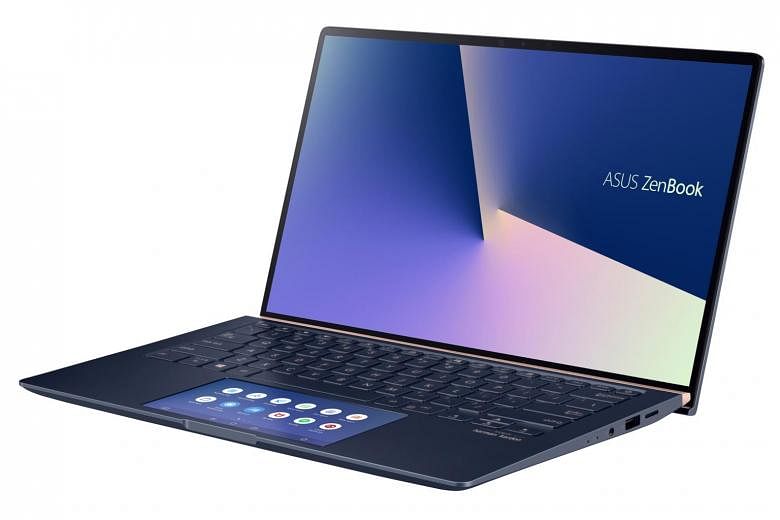Asus turned the touchpad into a second screen on last year's ZenBook Pro.
This so-called ScreenPad, about the size of a smartphone display, can be used to perform various tasks such as handwriting and numeric input. Helper tools created by Asus also lets this screen show additional commands in compatible apps like Microsoft Office.
An improved version, dubbed ScreenPad 2.0, is found in the latest Asus ZenBook 14 (UX434). The Taiwanese PC maker says the new version is more power efficient, despite the screen size increasing from 5.5 inches to 5.65 inches.
Navigating the ScreenPad and moving app windows between the ScreenPad and the ZenBook's main 14-inch screen are also easier than before with its new Android-like user interface.
But despite the improvements, I still do not see myself using the ScreenPad regularly.
Occasionally, I may use the second screen to watch a YouTube tutorial for an app or a game while following the instructions on the main screen. I can also place my Spotify app window in the ScreenPad to view my playlist at a glance.
But I can do these tasks using my smartphone. In short, there are no compelling reasons for me to deal with the ScreenPad's occasional bugs, its poor viewing angles and more importantly, its negative impact on battery life.
In my testing, the ZenBook lasted 6hr 13 mins in our usual video-loop battery test with the main screen at full brightness and the ScreenPad set at 50 per cent brightness. The laptop lasted almost eight hours in the same test with the ScreenPad turned off.
The good news is that the ScreenPad can be disabled easily with a shortcut key. The laptop itself is very similar to the ZenBook 14 (UX433) model that I tested in January this year.
Its blue aluminium lid bears the distinctive look of the Asus ZenBook series - concentric circles reminiscent of water ripples. Because of its touchscreen, the newer UX434 model weighs 1.35kg compared to 1.1kg for the UX433 version.
But you probably won't be able to tell between the two by their heft. The new model is just as compact, thanks to a slim bezel design that reduces the laptop's footprint. Asus also managed to cram an infrared facial recognition camera above the screen in the narrow bezel.
The keyboard offers decent key travel and does not feel as shallow as some thinner ultrabooks. There are three levels of brightness for the keyboard backlight.
The newer UX434 has the same mix of connectors as the older model. Useful ones include HDMI and a microSD card reader, though the inclusion of a slow USB 2.0 port is bewildering. The similarities between the two ZenBooks extend to the hardware specs. Both laptops come with Intel's Core i7-8565U processor with 16GB of system memory and a 1TB solid-state drive.
The newer UX434 does have a slightly updated MX250 graphics chip, though its performance in PCMark 10's digital content creation segment is only slightly better than the MX150 in the older UX433 laptop.
Despite the improvements, the ScreenPad still has more downsides than benefits for me. But that aside, the ZenBook is a solid ultrabook that offers both performance and portability.
FOR
Sturdy and well-made chassis
Thin screen bezel
Good performance
AGAINST
ScreenPad has limited usefulness and consumes power while in use
USB 2.0 port
SPECS
Price: $2,098
Processor: Intel Core i7-8565U (1.8GHz)
Graphics: Nvidia GeForce MX250 2GB GDDR5
RAM: 16GB DDR3
Screen size: 14 inches, 1,920 x 1,080 pixels
Connectivity: USB 3.1 Type-C Gen 2, USB 3.1 Type-A Gen 2, USB 2.0, HDMI, microSD card reader, audio jack
Battery: 50 watt-hour
RATING
Features: 4/5
Design: 4/5
Performance: 4/5
Value for money: 3.5/5
Battery life: 4.5/5
Overall: 4/5


